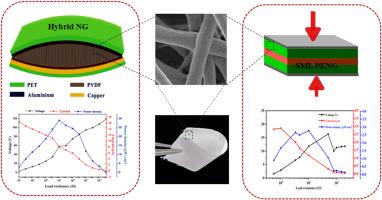Flexible piezoelectric and hybrid nanogenerators based on single layered and stacked multilayered PVDF/CoFe2O4/KNaNbO3 composite electrospun nanofibers
IF 4.1
2区 化学
Q2 POLYMER SCIENCE
引用次数: 0
Abstract
Poly(vinylidene fluoride) (PVDF) nanofibrous films, produced through electrospinning, offer high fraction of electroactive phases, high surface-to-volume ratio, porosity, low weight, and increased length, making them promising candidates for portable and self-powered device technology. Apart from electrospinning, the addition of nanofillers is known to enhance the electroactive responses of PVDF. This work investigates the influence of magnetostrictive and ferromagnetic CoFe2O4 (CFO) and highly piezoelectric KNaNbO3 (KNN) ceramics, dispersed in a lead-free PVDF matrix, serving as magnetic and electric counterparts, respectively. The incorporation of CFO and KNN nanoparticles enhanced the β-phase content of PVDF nanofibers and improved its dielectric and mechanical strength. The energy harvesting performance of the different PVDF-nanocomposites was studied in detail by fabricating single layered piezoelectric nanogenerators (PENGs), stacked multi-layered (SML) PENGs, and hybrid piezo-tribo nanogenerators. The hybrid device based on PVDF/CFO exhibited a peak output voltage of 120 V, a short-circuit current of 21 μA under 9 N applied force, and a power density of 28.5 μW/cm2 at 107 Ω load resistance. Hence, the present system could act as an active component in self-sustainable and portable mechanical energy harvesting devices and sensors.


求助全文
约1分钟内获得全文
求助全文
来源期刊

Polymer
化学-高分子科学
CiteScore
7.90
自引率
8.70%
发文量
959
审稿时长
32 days
期刊介绍:
Polymer is an interdisciplinary journal dedicated to publishing innovative and significant advances in Polymer Physics, Chemistry and Technology. We welcome submissions on polymer hybrids, nanocomposites, characterisation and self-assembly. Polymer also publishes work on the technological application of polymers in energy and optoelectronics.
The main scope is covered but not limited to the following core areas:
Polymer Materials
Nanocomposites and hybrid nanomaterials
Polymer blends, films, fibres, networks and porous materials
Physical Characterization
Characterisation, modelling and simulation* of molecular and materials properties in bulk, solution, and thin films
Polymer Engineering
Advanced multiscale processing methods
Polymer Synthesis, Modification and Self-assembly
Including designer polymer architectures, mechanisms and kinetics, and supramolecular polymerization
Technological Applications
Polymers for energy generation and storage
Polymer membranes for separation technology
Polymers for opto- and microelectronics.
 求助内容:
求助内容: 应助结果提醒方式:
应助结果提醒方式:


